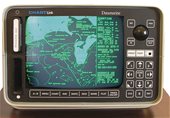Nautical GPS, also called marine GPS or marine navigator, but also called in nautical jargon as chartplotter or plotter, is an essential element to help navigation.
Nautical GPS is a technology born entirely in Italy, many years before the first road navigator.
In 1983 Fosco Bianchetti and Giuseppe Carnevali were commissioned to build the first marine navigator in history to be installed on a mega yacht of an Arab Emir.
At that time there was the loran as a positioning tool and there were already some monitors that tracked the path of the boat, but not overlapping with a cartography.
This implementation was not easy because the processors of the time were not suitable to manipulate graphics and also the available memory was very limited. But a series of optimizations both from the hardware and software point of view, allowed the 2 engineers to complete this great undertaking, even if with a really primitive cartography and on a cathode ray tube monitor with green phosphors.
Subsequently, the two engineers aware of the commercial potential of their invention, in 1984 produced the first chartplotters for commercial purposes by founding the company Navionic (without the final "s").
In 1985 two different points of view divided the two engineers, Mr. Bianchetti believed that a real commercial breakthrough could only be achieved by saving on hardware costs and this would also slow down the entry of formidable competitors in this market, while Mr. Carnevali believed that satisfactory results had been achieved and that however this technology for some years would be reserved for a small niche market.
So Eng. Bianchetti founded the C-Map, while Eng. Carnevali founded Navionics.
In the following years, the market proved Mr. Bianchetti right, in fact there followed a rapid expansion of the marketing of the plotter and then the economisation of the hardware gave its results. In addition, Mr. Bianchetti, in some way the true technical creator of the first Nautical GPS in history (while Mr. Carnevali was mainly in charge of commercial relations), could count not only on his know-how but also on that of valid collaborators, some of whom were already involved in the first projects.
Carnevali also had his satisfaction, in fact he managed to sell the entire lot of plotters built with first-generation hardware, confirming that his theory was also correct.
Subsequently, both C-Map and Navionics dedicated their efforts to ensuring that other manufacturers used their own cartography and over time increasingly spread as manufacturers of nautical electronic cartography and not hardware (plotters).
In 2007 C-Map was acquired by Jeppesen (of the Boeing group) and its trade name became C-Map by Jeppesen.
Today, in addition to being many manufacturers of nautical GPS, there are also several manufacturers of cartography, but even today the cartographies of C-Map by Jeppesen and Navionics, are by far the most widespread in the world and according to almost all experts the best.
